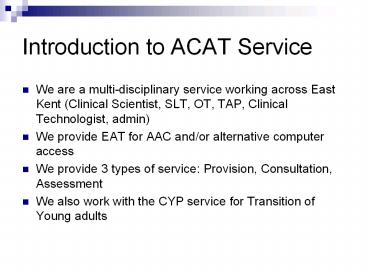Introduction to ACAT Service - PowerPoint PPT Presentation
1 / 17
Title:
Introduction to ACAT Service
Description:
No clients were using any low tech communication books at the time of referral. High tech AAC intervention AAC assessment/provision. – PowerPoint PPT presentation
Number of Views:74
Avg rating:3.0/5.0
Title: Introduction to ACAT Service
1
Introduction to ACAT Service
- We are a multi-disciplinary service working
across East Kent (Clinical Scientist, SLT, OT,
TAP, Clinical Technologist, admin) - We provide EAT for AAC and/or alternative
computer access - We provide 3 types of service Provision,
Consultation, Assessment - We also work with the CYP service for Transition
of Young adults
2
What are we learning from our clients with
aphasia who use high tech AAC?
- Fiona Panthi and Karen Reed
- Adult Communication and Assistive Technology
Service
3
Stroke and Aphasia
- Our focus is aphasia as a consequence of a
stroke. - Aphasia is an impairment of language, affecting
the production or comprehension of speech and the
ability to read or write. Aphasia is often
associated with concomitant disorders e.g.
apraxia of speech.
4
The clients
- Seven clients (one female/ six male) with aphasia
and apraxia of speech. - Clients were seen between one and ten years post
stroke. - All clients are able to use direct access.
5
The families
- Six clients are married with family support.
- One client with limited family support.
- Four spouses retired.
- Two spouses working and out for long periods.
6
Augmentative and Alternative Communication what
was in place?
- Clients were using a variety of methods to
communicate air writing, white board/pen/paper,
pointing and gestures. - No clients were using any low tech communication
books at the time of referral.
7
High tech AAC intervention
- AAC assessment/provision. Identification of
appropriate communication apps and
personalisation/customisation of vocabulary. - Training provided and support visits for the
clients and their families. - AAC user group
- Joint working with community speech therapists
and the Stroke Association.
8
Making good use of high tech AAC
- Clients using other apps and features to augment
communication e.g. Google maps, showing
photographs. - Helpful for social interaction sharing news and
holiday photographs. - Toggling between symbols/keyboard.
9
Obstacles to successful use of high tech AAC
- Majority of clients not having regular/any
opportunities to use their communication aid with
family or other communication partners. Family
beliefs re AAC? - Lack of conversation partners. Social isolation,
in some cases. - Families possibly unaware of the commitment
required from them to support the client both
technically and during day to day conversations.
10
Obstacles language
- Clients appeared disappointed with the limited
vocabulary available on the device. - Difficulties with symbol recognition especially
abstract symbols. - Limited use of AAC during speech and language
therapy sessions as client focus appeared to be
improving upon impaired skills.
11
Obstacles other
- Family saying they get by with usual method of
communication. - iPad proving a distraction for some clients.
- Clients rarely using their AAC out of home
environment.
12
AAC User Group
- Held in November 2012, clients/families/carers/SLT
s attended, 100 attendance. - Activities to build on AAC skills for both client
and family. - Social opportunity to meet and make friends.
- Positive feedback.
13
AAC intervention what went well?
- Clients with some residual literacy skills were
able to use predictive text and keyboard. - AAC enabled one client to interact with his young
daughter, sing songs and play games. - Widened social interaction possibilities, enabled
clients to have control over topic of
conversation.
14
Cont..what went well?
- Clients and families contributed to selection of
vocabulary. - Using AAC with new conversation ptnrs.
- Better outcome when clients were familiar with
technology. - Initial rejection of AAC then acceptance.
- AAC User Group.
15
What have we learnt?
- High tech AAC intervention can be a convoluted
process, so many considerations. - Clients/families expectations and beliefs re AAC
vs our (ACAT) expectations and what we are hoping
to achieve. - Communication opportunities are paramount!
- Time and commitment required by all involved.
- Most clients were partner dependent communicators
re using their AAC. - Acceptance and readiness for AAC re clients and
their families. - Speech therapy AAC not always part of this
process.
16
Looking forwards
- Embed AAC early in speech therapy intervention.
- Be very clear regarding time for
learning/training and the commitment required to
help achieve positive outcomes. - One size cannot fit all when it comes to making
decisions about treatment approaches.
(Mahendra,2011). Continue to shape service
delivery. - Regular AAC user groups.
- The need for Conversation Partners. Increasing
social participation and activities. - Managing expectations Clients and their families
17
References
- Beck, a R (2011) AAC and message enhancement or
persons with aphasia chap 6. in Augmentative and
Alternative Communication for Adults with
Aphasia. ED Koul, R. Emerald Group Publishing.
UK. - Phillips,P. (2009) Can People with Aphasia Use
High-tech AAC? Communication Matters 23 (1)
p23-26. - Robertson, E. Schneider, H.(2011) Not a
bandage. Advocating AAC assessment in aphasia.
Communication Matters 25 (2) p15-16. - Mahendra, N (2011) Overview of Aphasia and
Approaches to Aphasia Intervention chap 2. in
Augmentative and Alternative Communication for
Adults with Aphasia. ED Koul, R. Emerald Group
Publishing. UK.































